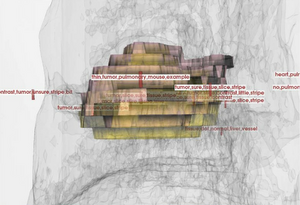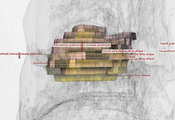Information
- Publication Type: Master Thesis
- Workgroup(s)/Project(s): not specified
- Date: 2022
- Date (Start): March 2022
- Date (End): December 2022
- TU Wien Library:
- Second Supervisor: Renata Raidou
- Diploma Examination: 16. January 2023
- Open Access: yes
- First Supervisor: Manuela Waldner
- Pages: 145
- Keywords: medical visualization, uncertainty, inter-observer variability, data acquisition, segmentation, manual delineation
Abstract
Despite the advancements in auto-segmentation tools, manual delineation is still necessary in the medical field. For example, tumor segmentation is a crucial step in cancer radiotherapy and is still widely performed by hand by experienced radiologists. However, the opinions of experienced radiologists might differ, for a multitude of reasons. In this work, we visualize the variability originating from multiple experts delineating medical scans of the same patient, known as inter-observer variability.The novelty of this work consists of capturing the process of segmenting a target object. The focus lies in gaining insight into the observer’s thought processes and reasoning strategies. To investigate these aspects of segmenting we conduct a data acquisitionwith novice users and experts, capturing their thoughts in a think-aloud protocol and their areas of attention by tracking their mouse-movement during the segmentation process. This data is visualized with our Multi Observer Looking Environment (MOLE).MOLE allows to gain deep insight into the observers’ segmentation process and enables to compare different segmentation outcomes and how these occurred. With our proposed visualization techniques we emphasize regions of uncertainty that need more attention when delineating. Additionally, relevant keywords are extracted from the think-aloud protocol and aligned with the positions in the segmentation, providing information about the thought process of an observer. We link the initial image to a three-dimensional representation of the delineations and provide more details of the think-aloud protocol on demand.Our approach is universal to segmentation, attention and thought process data regardless of the domain of the data. We show how MOLE can be used with a medical dataset as well as an artificially created dataset. By validating our approach with the help of a medical expert actively working in the field, we define potential use cases in the existing pipeline of tumor delineation for cancer treatment.Additional Files and Images
Weblinks
BibTeX
@mastersthesis{bayat-2022-mva,
title = "Multi-faceted Visual Analysis of Inter-Observer Variability",
author = "Hannah Clara Bayat",
year = "2022",
abstract = "Despite the advancements in auto-segmentation tools, manual
delineation is still necessary in the medical field. For
example, tumor segmentation is a crucial step in cancer
radiotherapy and is still widely performed by hand by
experienced radiologists. However, the opinions of
experienced radiologists might differ, for a multitude of
reasons. In this work, we visualize the variability
originating from multiple experts delineating medical scans
of the same patient, known as inter-observer variability.The
novelty of this work consists of capturing the process of
segmenting a target object. The focus lies in gaining
insight into the observer’s thought processes and
reasoning strategies. To investigate these aspects of
segmenting we conduct a data acquisitionwith novice users
and experts, capturing their thoughts in a think-aloud
protocol and their areas of attention by tracking their
mouse-movement during the segmentation process. This data is
visualized with our Multi Observer Looking Environment
(MOLE).MOLE allows to gain deep insight into the
observers’ segmentation process and enables to compare
different segmentation outcomes and how these occurred. With
our proposed visualization techniques we emphasize regions
of uncertainty that need more attention when delineating.
Additionally, relevant keywords are extracted from the
think-aloud protocol and aligned with the positions in the
segmentation, providing information about the thought
process of an observer. We link the initial image to a
three-dimensional representation of the delineations and
provide more details of the think-aloud protocol on
demand.Our approach is universal to segmentation, attention
and thought process data regardless of the domain of the
data. We show how MOLE can be used with a medical dataset as
well as an artificially created dataset. By validating our
approach with the help of a medical expert actively working
in the field, we define potential use cases in the existing
pipeline of tumor delineation for cancer treatment.",
pages = "145",
address = "Favoritenstrasse 9-11/E193-02, A-1040 Vienna, Austria",
school = "Research Unit of Computer Graphics, Institute of Visual
Computing and Human-Centered Technology, Faculty of
Informatics, TU Wien",
keywords = "medical visualization, uncertainty, inter-observer
variability, data acquisition, segmentation, manual
delineation",
URL = "https://www.cg.tuwien.ac.at/research/publications/2022/bayat-2022-mva/",
}

 Master thesis
Master thesis

